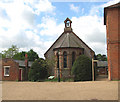1
Eelsfoot
House on Litcham Road.
Image: © JThomas
Taken: 16 Sep 2017
0.01 miles
2
Gressenhall Road at its junction with Litcham Road, Gressenhall
Image: © habiloid
Taken: 23 Aug 2021
0.02 miles
3
Sheep grazing off Litcham Road
Image: © JThomas
Taken: 16 Sep 2017
0.08 miles
4
Litcham Road towards Beetley
Looking north east.
Image: © JThomas
Taken: 16 Sep 2017
0.10 miles
5
Litcham Road, Gressenhall
Image: © habiloid
Taken: 23 Aug 2021
0.15 miles
6
Litcham Road entering Gressenhall
Image: © habiloid
Taken: 23 Aug 2021
0.15 miles
7
Dodson Drive, Gressenhall
Image: © habiloid
Taken: 23 Aug 2021
0.20 miles
8
Gressenhall Farm - farm track
Gressenhall Farm > http://www.geograph.org.uk/photo/1309724 - it is marked as Union Farm on OS maps - forms part of the Museum of Norfolk Life which is housed in the former union workhouse > http://www.geograph.org.uk/photo/1309477 - http://www.geograph.org.uk/photo/1309516 - http://www.geograph.org.uk/photo/1309546 located across Gressenhall Road (in adjacent grid square to the north). Run as a traditional 1920s farm, rare breed animals can be seen grazing the pastures and Suffolk Punch horses are working the fields. The Suffolk Punch is one of the oldest breeds of working horse recorded in the UK, with a history that can be traced back to the 18th century. The pastures are grazed by Red Poll cattle - a naturally hornless breed originally kept for milk, meat and leather - and by Norfolk Horn sheep > http://www.geograph.org.uk/photo/1309786 which were almost extinct a few decades ago. Their wool once formed the basis of Norfolk’s medieval wealth. The farm also keeps Large Black pigs, goats and chickens. http://www.museums.norfolk.gov.uk/default.asp?Document=200.50.040
Image: © Evelyn Simak
Taken: 18 May 2009
0.20 miles
9
View southwest along Gressenhall Road
Gressenhall Road separates Union House > http://www.geograph.org.uk/photo/1309477 - the former Gressenhall workhouse - from Union Farm > http://www.geograph.org.uk/photo/1309724. Presently the complex houses the Gressenhall Farm and Workhouse Museum of Norfolk Life.
Image: © Evelyn Simak
Taken: 18 May 2009
0.20 miles
10
Union House - the workhouse chapel
The workhouse chapel > http://www.geograph.org.uk/photo/1309609 - http://www.geograph.org.uk/photo/1309612 - http://www.geograph.org.uk/photo/1309629 was built by the architect Richard Phipson in 1868, for the use of the workhouse inmates. Before then services were held in the main hall of the workhouse. The chapel is built from flint and brick and has an octagonal apse at its east end. Besides being part of the museum the building is presently used for concerts and other functions.
When poverty increased due to the growth of the population and other economic and social changes in the second half of the 18th century, the scale of the problem encouraged the local authorities to consider new approaches. In 1774 a group of magistrates in the 'hundreds' of Mitford and Launditch proposed that all of the parishes in those districts should combine to build one large 'house of industry' where the helpless could be properly looked after and those capable of work could be profitably employed. In 1776 Chapel Farm - an estate of almost 62 acres in Gressenhall - was purchased. Between 1777 and 1794 the house had an average number of 450 inmates, with a highest total level of 670 in 1801. There were 'cottages' or apartments for married couples in the eastern wing and the sick were being cared for in the building which had been Chapel Farm. 'Women of bad character' were kept apart from the other inmates and had to wear distinctive clothing so as to be easily recognised.
Before 1836 the inmates received regular meals, including vegetables and bread made with flour from a windmill erected in 1781 and beer which was brewed on the premises. With the introduction of the 'new poor law', Gressenhall became a union workhouse. Its inmates were divided into separate categories, a process which entailed the separation of husbands and wives, and the married couples' 'cottages' were replaced by dormitories and day rooms. Unmarried mothers were still distinguished by being made to wear a 'jacket' made of the same material as the other workhouse clothes. Discipline was very strict, the inmates' diet after 1836 was meagre and monotonous, and although the daily routine and hours of work were similar to those in the house of industry in the 1700s, the inmates now received no payment for their work, except for a few who were rewarded for particular responsibilities with small gratuities. It was mainly the children who appeared to have benefited from the new system - the workhouse schools at Gressenhall were large and, by the standards of the time, progressive.
In 1853, the building which is now Cherry Tree Cottage > http://www.geograph.org.uk/photo/1309548 was erected to provide accommodation for aged married couples - the first relaxation in the policy of segregation of the sexes. And a chapel was erected with funds raised by private subscription and opened on 2nd December 1868. By the turn of the century the initial harshness of the new poor law had softened but the workhouse was still hated and feared by the poor.
The workhouse > http://www.geograph.org.uk/photo/1309504 complex included the village row > http://www.geograph.org.uk/photo/1309567 which housed the village shop > http://www.geograph.org.uk/photo/1309572 and the post office > http://www.geograph.org.uk/photo/1309576 with a school room adjoining at one end > http://www.geograph.org.uk/photo/1309579.
After the National Assistance Act had brought an end to the poor law in 1948 the main buildings continued to provide accommodation for the elderly until 1974. In 1975, the entire site was transferred to the then Norfolk Museums Service, and the Norfolk Rural Life Museum was opened a year later. The workhouse buildings were repaired and restored, and displays are now telling the story of the workhouse and its inmates in depth for the first time. http://www.museums.norfolk.gov.uk/img/gressenhallworkhouse3.pdf
Image: © Evelyn Simak
Taken: 18 May 2009
0.20 miles











